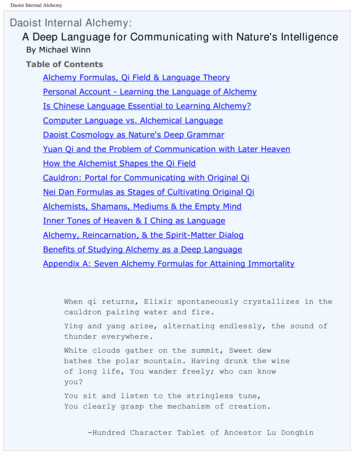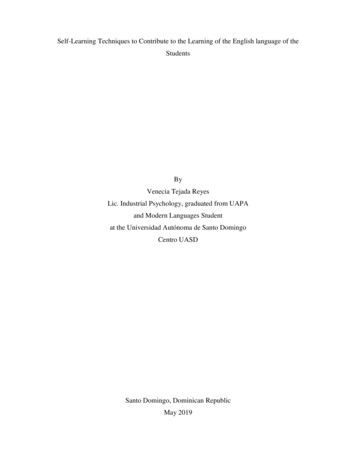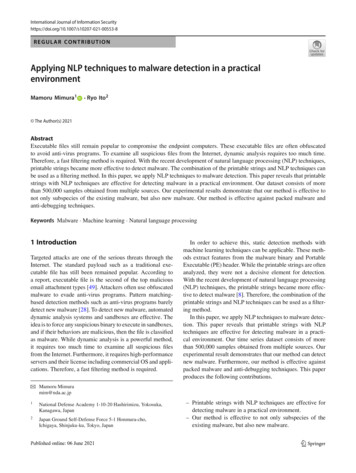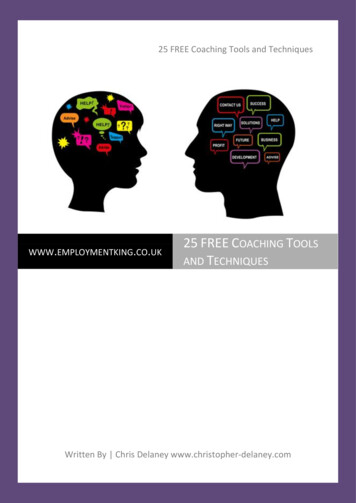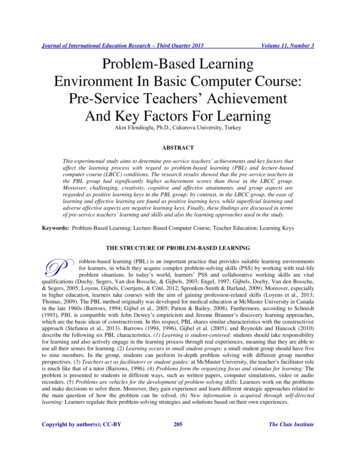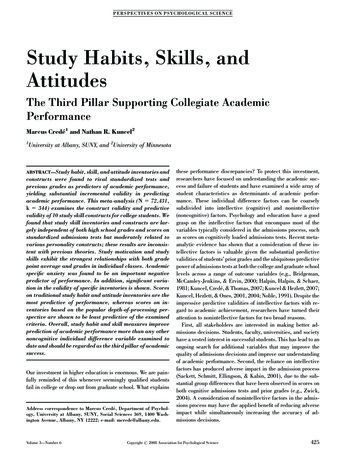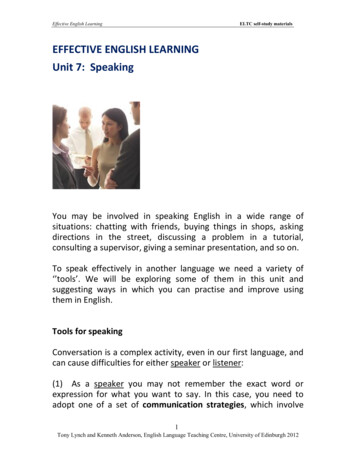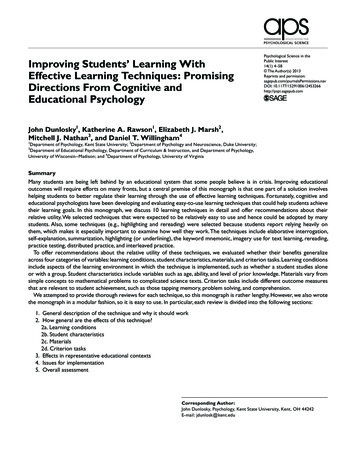
Transcription
Improving Students’ Learning WithEffective Learning Techniques: PromisingDirections From Cognitive andEducational PsychologyPsychological Science in thePublic Interest14(1) 4 –58 The Author(s) 2013Reprints and permission:sagepub.com/journalsPermissions.navDOI: n Dunlosky1, Katherine A. Rawson1, Elizabeth J. Marsh2 ,Mitchell J. Nathan3, and Daniel T. Willingham41Department of Psychology, Kent State University; 2Department of Psychology and Neuroscience, Duke University;Department of Educational Psychology, Department of Curriculum & Instruction, and Department of Psychology,University of Wisconsin–Madison; and 4Department of Psychology, University of Virginia3SummaryMany students are being left behind by an educational system that some people believe is in crisis. Improving educationaloutcomes will require efforts on many fronts, but a central premise of this monograph is that one part of a solution involveshelping students to better regulate their learning through the use of effective learning techniques. Fortunately, cognitive andeducational psychologists have been developing and evaluating easy-to-use learning techniques that could help students achievetheir learning goals. In this monograph, we discuss 10 learning techniques in detail and offer recommendations about theirrelative utility. We selected techniques that were expected to be relatively easy to use and hence could be adopted by manystudents. Also, some techniques (e.g., highlighting and rereading) were selected because students report relying heavily onthem, which makes it especially important to examine how well they work. The techniques include elaborative interrogation,self-explanation, summarization, highlighting (or underlining), the keyword mnemonic, imagery use for text learning, rereading,practice testing, distributed practice, and interleaved practice.To offer recommendations about the relative utility of these techniques, we evaluated whether their benefits generalizeacross four categories of variables: learning conditions, student characteristics, materials, and criterion tasks. Learning conditionsinclude aspects of the learning environment in which the technique is implemented, such as whether a student studies aloneor with a group. Student characteristics include variables such as age, ability, and level of prior knowledge. Materials vary fromsimple concepts to mathematical problems to complicated science texts. Criterion tasks include different outcome measuresthat are relevant to student achievement, such as those tapping memory, problem solving, and comprehension.We attempted to provide thorough reviews for each technique, so this monograph is rather lengthy. However, we also wrotethe monograph in a modular fashion, so it is easy to use. In particular, each review is divided into the following sections:1. General description of the technique and why it should work2. How general are the effects of this technique?2a. Learning conditions2b. Student characteristics2c. Materials2d. Criterion tasks3. Effects in representative educational contexts4. Issues for implementation5. Overall assessmentCorresponding Author:John Dunlosky, Psychology, Kent State University, Kent, OH 44242E-mail: jdunlosk@kent.edu
Improving Student Achievement5The review for each technique can be read independently of the others, and particular variables of interest can be easilycompared across techniques.To foreshadow our final recommendations, the techniques vary widely with respect to their generalizability and promisefor improving student learning. Practice testing and distributed practice received high utility assessments because they benefitlearners of different ages and abilities and have been shown to boost students’ performance across many criterion tasks andeven in educational contexts. Elaborative interrogation, self-explanation, and interleaved practice received moderate utilityassessments. The benefits of these techniques do generalize across some variables, yet despite their promise, they fell shortof a high utility assessment because the evidence for their efficacy is limited. For instance, elaborative interrogation and selfexplanation have not been adequately evaluated in educational contexts, and the benefits of interleaving have just begun to besystematically explored, so the ultimate effectiveness of these techniques is currently unknown. Nevertheless, the techniquesthat received moderate-utility ratings show enough promise for us to recommend their use in appropriate situations, which wedescribe in detail within the review of each technique.Five techniques received a low utility assessment: summarization, highlighting, the keyword mnemonic, imagery use for textlearning, and rereading. These techniques were rated as low utility for numerous reasons. Summarization and imagery use fortext learning have been shown to help some students on some criterion tasks, yet the conditions under which these techniquesproduce benefits are limited, and much research is still needed to fully explore their overall effectiveness.The keyword mnemonicis difficult to implement in some contexts, and it appears to benefit students for a limited number of materials and for shortretention intervals. Most students report rereading and highlighting, yet these techniques do not consistently boost students’performance, so other techniques should be used in their place (e.g., practice testing instead of rereading).Our hope is that this monograph will foster improvements in student learning, not only by showcasing which learningtechniques are likely to have the most generalizable effects but also by encouraging researchers to continue investigating themost promising techniques. Accordingly, in our closing remarks, we discuss some issues for how these techniques could beimplemented by teachers and students, and we highlight directions for future research.IntroductionIf simple techniques were available that teachers and studentscould use to improve student learning and achievement, wouldyou be surprised if teachers were not being told about thesetechniques and if many students were not using them? What ifstudents were instead adopting ineffective learning techniquesthat undermined their achievement, or at least did not improveit? Shouldn’t they stop using these techniques and begin usingones that are effective? Psychologists have been developingand evaluating the efficacy of techniques for study and instruction for more than 100 years. Nevertheless, some effectivetechniques are underutilized—many teachers do not learnabout them, and hence many students do not use them, despiteevidence suggesting that the techniques could benefit studentachievement with little added effort. Also, some learning techniques that are popular and often used by students are relatively ineffective. One potential reason for the disconnectbetween research on the efficacy of learning techniques andtheir use in educational practice is that because so many techniques are available, it would be challenging for educators tosift through the relevant research to decide which ones showpromise of efficacy and could feasibly be implemented by students (Pressley, Goodchild, Fleet, Zajchowski, & Evans,1989).Toward meeting this challenge, we explored the efficacy of10 learning techniques (listed in Table 1) that students coulduse to improve their success across a wide variety of contentdomains.1 The learning techniques we consider here were chosen on the basis of the following criteria. We chose sometechniques (e.g., self-testing, distributed practice) because aninitial survey of the literature indicated that they could improvestudent success across a wide range of conditions. Other techniques (e.g., rereading and highlighting) were includedbecause students report using them frequently. Moreover, students are responsible for regulating an increasing amount oftheir learning as they progress from elementary grades throughmiddle school and high school to college. Lifelong learnersalso need to continue regulating their own learning, whetherit takes place in the context of postgraduate education, theworkplace, the development of new hobbies, or recreationalactivities.Thus, we limited our choices to techniques that could beimplemented by students without assistance (e.g., withoutrequiring advanced technologies or extensive materials thatwould have to be prepared by a teacher). Some training maybe required for students to learn how to use a technique withfidelity, but in principle, students should be able to use thetechniques without supervision. We also chose techniques forwhich a sufficient amount of empirical evidence was availableto support at least a preliminary assessment of potential efficacy. Of course, we could not review all the techniques thatmeet these criteria, given the in-depth nature of our reviews,and these criteria excluded some techniques that show muchpromise, such as techniques that are driven by advancedtechnologies.Because teachers are most likely to learn about these techniques in educational psychology classes, we examinedhow some educational-psychology textbooks covered them(Ormrod, 2008; Santrock, 2008; Slavin, 2009; Snowman,
6Dunlosky et al.Table 1. Learning TechniquesTechnique1. Elaborative interrogation2. Self-explanation3. Summarization4. Highlighting/underlining5. Keyword mnemonic6. Imagery for text7. Rereading8. Practice testing9. Distributed practice10. Interleaved practiceDescriptionGenerating an explanation for why an explicitly stated fact or concept is trueExplaining how new information is related to known information, or explaining steps takenduring problem solvingWriting summaries (of various lengths) of to-be-learned textsMarking potentially important portions of to-be-learned materials while readingUsing keywords and mental imagery to associate verbal materialsAttempting to form mental images of text materials while reading or listeningRestudying text material again after an initial readingSelf-testing or taking practice tests over to-be-learned materialImplementing a schedule of practice that spreads out study activities over timeImplementing a schedule of practice that mixes different kinds of problems, or a schedule ofstudy that mixes different kinds of material, within a single study sessionNote. See text for a detailed description of each learning technique and relevant examples of their use.Table 2. Examples of the Four Categories of Variables for GeneralizabilityMaterialsVocabularyTranslation equivalentsLecture contentScience definitionsNarrative textsExpository textsMathematical conceptsMapsDiagramsLearning conditionsAmount of practice (dosage)Open- vs. closed-book practiceReading vs. listeningIncidental vs. intentional learningDirect instructionDiscovery learningRereading lagsbKind of practice testscGroup vs. individual learningStudent characteristicsaAgePrior domain knowledgeWorking memory capacityVerbal abilityInterestsFluid intelligenceMotivationPrior achievementSelf-efficacyCriterion tasksCued recallFree recallRecognitionProblem solvingArgument developmentEssay writingCreation of portfoliosAchievement testsClassroom quizzesaSome of these characteristics are more state based (e.g., motivation) and some are more trait based (e.g., fluid intelligence); this distinction isrelevant to the malleability of each characteristic, but a discussion of this dimension is beyond the scope of this article.bLearning condition is specific to rereading.cLearning condition is specific to practice testing.McCown, & Biehler, 2009; Sternberg & Williams, 2010;Woolfolk, 2007). Despite the promise of some of the techniques, many of these textbooks did not provide sufficientcoverage, which would include up-to-date reviews of theirefficacy and analyses of their generalizability and potentiallimitations. Accordingly, for all of the learning techniqueslisted in Table 1, we reviewed the literature to identify the generalizability of their benefits across four categories of variables—materials, learning conditions, student characteristics,and criterion tasks. The choice of these categories was inspiredby Jenkins’ (1979) model (for an example of its use in educational contexts, see Marsh & Butler, in press), and examples ofeach category are presented in Table 2. Materials pertain to thespecific content that students are expected to learn, remember,or comprehend. Learning conditions pertain to aspects ofthe context in which students are interacting with the to-belearned materials. These conditions include aspects of thelearning environment itself (e.g., noisiness vs. quietness in aclassroom), but they largely pertain to the way in which alearning technique is implemented. For instance, a techniquecould be used only once or many times (a variable referred toas dosage) when students are studying, or a technique could beused when students are either reading or listening to the to-belearned materials.Any number of student characteristics could also influencethe effectiveness of a given learning technique. For example,in comparison to more advanced students, younger students inearly grades may not benefit from a technique. Students’ basiccognitive abilities, such as working memory capacity or general fluid intelligence, may also influence the efficacy of agiven technique. In an educational context, domain knowledgerefers to the valid, relevant knowledge a student brings to alesson. Domain knowledge may be required for students to usesome of the learning techniques listed in Table 1. For instance,
7Improving Student Achievementthe use of imagery while reading texts requires that studentsknow the objects and ideas that the words refer to so that theycan produce internal images of them. Students with somedomain knowledge about a topic may also find it easier to useself-explanation and elaborative interrogation, which are twotechniques that involve answering “why” questions about aparticular concept (e.g., “Why would particles of ice rise upwithin a cloud?”). Domain knowledge may enhance the benefits of summarization and highlighting as well. Nevertheless,although some domain knowledge will benefit students asthey begin learning new content within a given domain, it isnot a prerequisite for using most of the learning techniques.The degree to which the efficacy of each learning techniqueobtains across long retention intervals and generalizes acrossdifferent criterion tasks is of critical importance. Our reviewsand recommendations are based on evidence, which typicallypertains to students’ objective performance on any number ofcriterion tasks. Criterion tasks (Table 2, rightmost column)vary with respect to the specific kinds of knowledge that theytap. Some tasks are meant to tap students’ memory for information (e.g., “What is operant conditioning?”), others arelargely meant to tap students’ comprehension (e.g., “Explainthe difference between classical conditioning and operant conditioning”), and still others are meant to tap students’ application of knowledge (e.g., “How would you apply operantconditioning to train a dog to sit down?”). Indeed, Bloom andcolleagues divided learning objectives into six categories,from memory (or knowledge) and comprehension of facts totheir application, analysis, synthesis, and evaluation (B. S.Bloom, Engelhart, Furst, Hill, & Krathwohl, 1956; for anupdated taxonomy, see L. W. Anderson & Krathwohl, 2001).In discussing how the techniques influence criterion performance, we emphasize investigations that have gone beyonddemonstrating improved memory for target material by measuring students’ comprehension, application, and transfer ofknowledge. Note, however, that although gaining factualknowledge is not considered the only or ultimate objective ofschooling, we unabashedly consider efforts to improve studentretention of knowledge as essential for reaching other instructional objectives; if one does not remember core ideas, facts,or concepts, applying them may prove difficult, if not impossible. Students who have forgotten principles of algebra willbe unable to apply them to solve problems or use them as afoundation for learning calculus (or physics, economics, orother related domains), and students who do not rememberwhat operant conditioning is will likely have difficultiesapplying it to solve behavioral problems. We are not advocating that students spend their time robotically memorizingfacts; instead, we are acknowledging the important interplaybetween memory for a concept on one hand and the ability tocomprehend and apply it on the other.An aim of this monograph is to encourage students to usethe appropriate learning technique (or techniques) to accomplish a given instructional objective. Some learning techniquesare largely focused on bolstering students’ memory for facts(e.g., the keyword mnemonic), others are focused more onimproving comprehension (e.g., self-explanation), and yetothers may enhance both memory and comprehension (e.g.,practice testing). Thus, our review of each learning techniquedescribes how it can be used, its effectiveness for producinglong-term retention and comprehension, and its breadth ofefficacy across the categories of variables listed in Table 2.Reviewing the Learning TechniquesIn the following series of reviews, we consider the availableevidence for the efficacy of each of the learning techniques.Each review begins with a brief description of the techniqueand a discussion about why it is expected to improve studentlearning. We then consider generalizability (with respect tolearning conditions, materials, student characteristics, and criterion tasks), highlight any research on the technique that hasbeen conducted in representative educational contexts, andaddress any identified issues for implementing the technique.Accordingly, the reviews are largely modular: Each of the 10reviews is organized around these themes (with correspondingheaders) so readers can easily identify the most relevant information without necessarily having to read the monograph inits entirety.At the end of each review, we provide an overall assessment for each technique in terms of its relatively utility—low,moderate, or high. Students and teachers who are not alreadydoing so should consider using techniques designated as highutility, because the effects of these techniques are robust andgeneralize widely. Techniques could have been designated aslow utility or moderate utility for any number of reasons. Forinstance, a technique could have been designated as low utilitybecause its effects are limited to a small subset of materialsthat students need to learn; the technique may be useful insome cases and adopted in appropriate contexts, but, relativeto the other techniques, it would be considered low in utilitybecause of its limited generalizability. A technique could alsoreceive a low- or moderate-utility rating if it showed promise,yet insufficient evidence was available to support confidencein assigning a higher utility assessment. In such cases, weencourage researchers to further explore these techniqueswithin educational settings, but students and teachers maywant to use caution before adopting them widely. Most important, given that each utility assessment could have beenassigned for a variety of reasons, we discuss the rationale for agiven assessment at the end of each review.Finally, our intent was to conduct exhaustive reviews ofthe literature on each learning technique. For techniques thathave been reviewed extensively (e.g., distributed practice),however, we relied on previous reviews and supplementedthem with any research that appeared after they had been published. For many of the learning techniques, too many articleshave been published to cite them all; therefore, in our discussion of most of the techniques, we cite a subset of relevantarticles.
81 Elaborative interrogationAnyone who has spent time around young children knows thatone of their most frequent utterances is “Why?” (perhaps coming in a close second behind “No!”). Humans are inquisitivecreatures by nature, attuned to seeking explanations for states,actions, and events in the world around us. Fortunately, a sizable body of evidence suggests that the power of explanatoryquestioning can be harnessed to promote learning. Specifically, research on both elaborative interrogation and selfexplanation has shown that prompting students to answer“Why?” questions can facilitate learning. These two literaturesare highly related but have mostly developed independently ofone another. Additionally, they have overlapping but nonidentical strengths and weaknesses. For these reasons, we considerthe two literatures separately.1.1 General description of elaborative interrogation andwhy it should work. In one of the earliest systematic studiesof elaborative interrogation, Pressley, McDaniel, Turnure,Wood, and Ahmad (1987) presented undergraduate studentswith a list of sentences, each describing the action of a particular man (e.g., “The hungry man got into the car”). In the elaborative-interrogation group, for each sentence, participantswere prompted to explain “Why did that particular man dothat?” Another group of participants was instead providedwith an explanation for each sentence (e.g., “The hungry mangot into the car to go to the restaurant”), and a third groupsimply read each sentence. On a final test in which participantswere cued to recall which man performed each action (e.g.,“Who got in the car?”), the elaborative-interrogation groupsubstantially outperformed the other two groups (collapsingacross experiments, accuracy in this group was approximately72%, compared with approximately 37% in each of the othertwo groups). From this and similar studies, Seifert (1993)reported average effect sizes ranging from 0.85 to 2.57.As illustrated above, the key to elaborative interrogationinvolves prompting learners to generate an explanation for anexplicitly stated fact. The particular form of the explanatoryprompt has differed somewhat across studies—examplesinclude “Why does it make sense that ?”, “Why is this true?”,and simply “Why?” However, the majority of studies haveused prompts following the general format, “Why would thisfact be true of this [X] and not some other [X]?”The prevailing theoretical account of elaborative-interrogation effects is that elaborative interrogation enhances learningby supporting the integration of new information with existingprior knowledge. During elaborative interrogation, learnerspresumably “activate schemata . . . These schemata, in turn,help to organize new information which facilitates retrieval”(Willoughby & Wood, 1994, p. 140). Although the integrationof new facts with prior knowledge may facilitate the organization (Hunt, 2006) of that information, organization alone is notsufficient—students must also be able to discriminate amongrelated facts to be accurate when identifying or using theDunlosky et al.learned information (Hunt, 2006). Consistent with this account,note that most elaborative-interrogation prompts explicitly orimplicitly invite processing of both similarities and differencesbetween related entities (e.g., why a fact would be true of oneprovince versus other provinces). As we highlight below, processing of similarities and differences among to-be-learnedfacts also accounts for findings that elaborative-interrogationeffects are often larger when elaborations are precise ratherthan imprecise, when prior knowledge is higher rather thanlower (consistent with research showing that preexistingknowledge enhances memory by facilitating distinctive processing; e.g., Rawson & Van Overschelde, 2008), and whenelaborations are self-generated rather than provided (a findingconsistent with research showing that distinctiveness effectsdepend on self-generating item-specific cues; Hunt & Smith,1996).1.2 How general are the effects of elaborativeinterrogation?1.2a Learning conditions. The seminal work by Pressley et al.(1987; see also B. S. Stein & Bransford, 1979) spawned aflurry of research in the following decade that was primarilydirected at assessing the generalizability of elaborative-interrogation effects. Some of this work focused on investigatingelaborative-interrogation effects under various learning conditions. Elaborative-interrogation effects have been consistentlyshown using either incidental or intentional learning instructions (although two studies have suggested stronger effects forincidental learning: Pressley et al., 1987; Woloshyn, Willoughby, Wood, & Pressley, 1990). Although most studieshave involved individual learning, elaborative-interrogationeffects have also been shown among students working indyads or small groups (Kahl & Woloshyn, 1994; Woloshyn &Stockley, 1995).1.2b Student characteristics. Elaborative-interrogation effectsalso appear to be relatively robust across different kinds oflearners. Although a considerable amount of work has involvedundergraduate students, an impressive number of studies haveshown elaborative-interrogation effects with younger learnersas well. Elaborative interrogation has been shown to improvelearning for high school students, middle school students, andupper elementary school students (fourth through sixth graders). The extent to which elaborative interrogation benefitsyounger learners is less clear. Miller and Pressley (1989) didnot find effects for kindergartners or first graders, and Wood,Miller, Symons, Canough, and Yedlicka (1993) reportedmixed results for preschoolers. Nonetheless, elaborative interrogation does appear to benefit learners across a relativelywide age range. Furthermore, several of the studies involvingyounger students have also established elaborative-interrogation effects for learners of varying ability levels, includingfourth through twelfth graders with learning disabilities (C.Greene, Symons, & Richards, 1996; Scruggs, Mastropieri, &Sullivan, 1994) and sixth through eighth graders with mild
9Improving Student Achievementcognitive disabilities (Scruggs, Mastropieri, Sullivan, & Hesser, 1993), although Wood, Willoughby, Bolger, Younger, andKaspar (1993) did not find effects with a sample of lowachieving students. On the other end of the continuum, elaborative-interrogation effects have been shown for high-achievingfifth and sixth graders (Wood & Hewitt, 1993; Wood, Willoughby, et al., 1993).Another key dimension along which learners differ is levelof prior knowledge, a factor that has been extensively investigated within the literature on elaborative interrogation. Bothcorrelational and experimental evidence suggest that priorknowledge is an important moderator of elaborative-interrogation effects, such that effects generally increase as priorknowledge increases. For example, Woloshyn, Pressley, andSchneider (1992) presented Canadian and German studentswith facts about Canadian provinces and German states. Thus,both groups of students had more domain knowledge for oneset of facts and less domain knowledge for the other set. Asshown in Figure 1, students showed larger effects of elaborative interrogation in their high-knowledge domain (a 24%increase) than in their low-knowledge domain (a 12%increase). Other studies manipulating the familiarity of to-belearned materials have reported similar patterns, with significant effects for new facts about familiar items but weaker ornonexistent effects for facts about unfamiliar items. Despitesome exceptions (e.g., Ozgungor & Guthrie, 2004), the overallconclusion that emerges from the literature is that high-knowledge learners will generally be best equipped to profit from theelaborative-interrogation technique. The benefit for lowerknowledge learners is less certain.One intuitive explanation for why prior knowledge moderates the effects of elaborative interrogation is that higherElaborative InterrogationReading Control80Final-Test Performance (%)706050403020100High KnowledgeLow KnowledgeFig. 1. Mean percentage of correct responses on a final test for learnerswith high or low domain knowledge who engaged in elaborative interrogation or in reading only during learning (in Woloshyn, Pressley, & Schneider,1992). Standard errors are not available.knowledge permits the generation of more appropriate explanations for why a fact is true. If so, one might expect final-testperformance to vary as a function of the quality of the explanations generated during study. However, the evidence is mixed.Whereas some studies have found that test performance is better following adequate elaborative-interrogation responses(i.e., those that include a precise, plausible, or accurate explanation for a fact) than for inadequate responses, the differenceshave often been small, and other studies have failed to finddifferences (although the numerical trends are usually in theanticipated direction). A somewhat more consistent finding isthat performance is better following an adequate response thanno response, although in this case, too, the results are somewhat mixed. More generally, the available evidence should beinterpreted with caution, given that outcomes are based onconditional post hoc analyses that likely reflect item-selectioneffects. Thus, the extent to which elaborative-interrogationeffects depend on the quality of the elaborations generated isstill an open question.1.2c Materials. Although several studies have replicatedelaborative-interrogation effects using the relatively artificial“man sentences” used by Pressley et al. (1987), the majority ofsubsequent research has extended these effects using materialsthat better represent what students are actually expected tolearn. The most commonly used materials involved sets offacts about various familiar and unfamiliar animals (e.g., “TheWestern Spotted Skunk’s hole is usually found on a sandypiece of farmland near crops”), usually with an elaborativeinterrogation prompt following t
use to improve their success across a wide variety of content domains.1 The learning techniques we consider here were cho-sen on the basis of the following criteria. We chose some techniques (e.g., self-testing, distributed practice) because an initial survey of the lite
